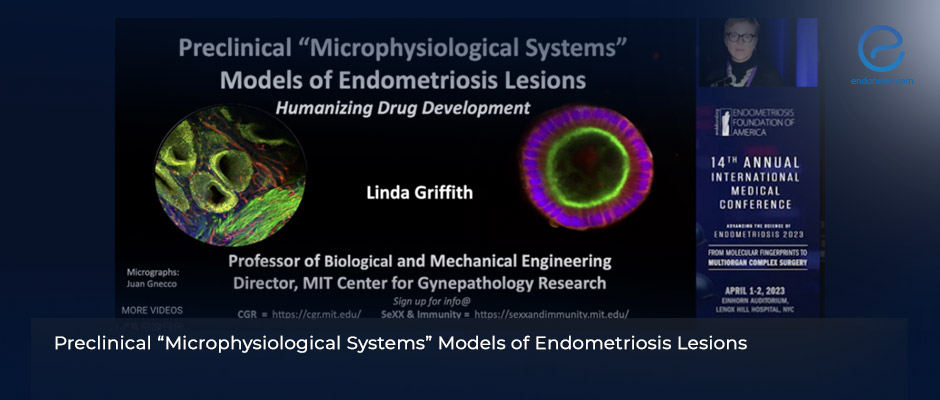Preclinical organ-on-chip models of endometriosis lesions - Linda Griffith, PhD
May 3, 2023
The models can help better understand the features of endometrial lesions and test compounds that could inhibit them.
Key Points
Highlights:
- Professor Griffith presented their preclinical organ on-chip models of endometriosis lesions at the Annual International Medical Conference of the Endometriosis Foundation of America held in New York on April 1-2, 2023.
Importance:
- These models can one day be used to test compounds that could inhibit the invasive phenotype of endometrial lesions.
What’s done here:
- Prof Griffith’s team developed a model that could capture the features of the human endometrium and endometrium-derived lesions.
Key results:
- The synthetic extracellular matrix that Prof. Griffith's team developed facilitated initial cell attachment, the accumulation of local cell-secreted extracellular matrix, and cell-mediated remodeling.
- The synthetic matrix enabled features of the menstrual cycle and enhanced the decidualization process that occurs in response to progesterone in healthy endometrial stromal cells.
- By recreating features of the stiff muscle microenvironment, Prof. Griffith and her team were able to test the proliferation rate and other features of endometriotic lesions.
Lay Summary
Professor Linda Griffith, Professor of Biological and Mechanical Engineering and the director of the Center for Gynepathology Research at Massachusetts Institute of Technology gave a presentation about their preclinical organ on-chip models of endometriosis lesions at the 14th Annual International Medical Conference of the Endometriosis Foundation of America held in New York on April 1-2, 2023.
During her talk entitled "Preclinical 'Microphysiologcal Systems' Models of Endometriosis Lesions - Humanizing Drug Development", Prof. Griffith described their models that “take patient samples and rebuild the patient in the lab”.
She started off by describing the inspirations that led to the development of their models including the fragility of blood vessels interacting with endometrial lesions, the heterogeneity that exists within the lesions, the tropism that endometriosis has for stiff tissues, the progesterone resistance of the lesions, and finally the cytokine signature present in some patients with endometriosis.
Prog Griffith then showed how their model captures these features including the interaction of a small lesion with stroma and epithelia. She also introduced their model of the eutopic endometrium. Their models, Prof, Giffith explained are based on epithelial organoids grown in culture and a modular synthetic extracellular matrix, which overcomes the problems associated with “Matrigel” which is often used to grow organoids.
She described how they developed the synthetic extracellular matrix and the advantages that it offers, including the facilitation of initial cell attachment, the accumulation of local cell-secreted extracellular matrix, and cell-mediated remodeling. Using their new matrix, the team was able to build an endometrium with multiple cell types.
Then they showed that their synthetic gel was not only able to enhance the decidualization process that occurs in response to progesterone in healthy endometrial stromal cells but also enables features of menstrual cycles in vitro. This can then be used to model inflammation cues and assess the response to progesterone, Giffith said.
“But . . . what we are interested in modeling”, she added “is not just the biochemical microenvironment but biophysical microenvironment” of the lesions. She explained that they worked to recreate features of the very stiff microenvironment that a lesion sitting in muscle would encounter as in the case of adenomyosis and showed how organoids grown in such an environment acquire an invasive phenotype. This model can then be used to characterize the proliferation rate and other features of lesions, she said.
Finally, Prof Griffith explained how using a microfluidic device, they were able to build a tissue that is mimicking the eutopic endometrium so that its temporal and spatial dynamics could be mapped in vitro.
Prof. Griffith finished off by showing how they are using their system to build micro vascularized lesions and study interactions between blood vessels and lesions and explained how one day their system could be used to inhibit the phenotypes that they identified using their model.
endometriosis model invasion microfluidic device extracellular matrix matrigel remodeling organoid

